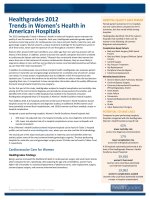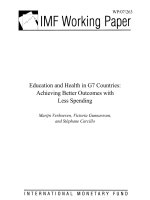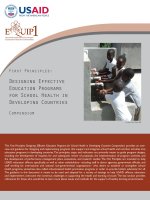updating antibiotic resistant trends in hap and vap in ap countries
Bạn đang xem bản rút gọn của tài liệu. Xem và tải ngay bản đầy đủ của tài liệu tại đây (4.73 MB, 37 trang )
Po-Ren Hsueh
National Taiwan University Hospital
Lancet Infect Dis 2008
Updating Antibiotic Resistant Trends
in HAP/VAP in AP Countries
HAP
(Ward)
VAP
(ICU)
HCAP
(Nursing Home)
Hospital-acquired Pneumonia
Hospital Mortality and
Inappropriate initial Antimicrobial Therapy
Based on Classification of Infection Source
Micek S T et al. Antimicrob Agents Chemother 2010;54:1742-8.
Masterton RG et al. J Antimicrob Chemother 2008;62:5-34.
Asian HAP Working Group. Am J Infect Control 2008;36:S83-92.
Am J Respir Crit Care Med 2005;171:388–416.
HCAP , HAP
Guidelines
Key Elements Driving Development of Bacterial
Resistance and Risk of Treatment Failure
Wiest R, et al. Gut 2012;61:297e310.
Local
epidemiology
and resistance
profiles
Severity
of
patients
KPC
NDM
CR-, MDR-, XDR-,
PDR-PA
CR-, MDR-, XDR-,
PDR-AB
Main MDRO in
Hospitals
Sputum from a ICU Patient
Predictors of Mortality for MDR GNB Infection
The study, The Patient, the Bug or the Drug?
Meta-analysis
Acinetobacter spp, P. aeruginosa, and Enterobacteriaceae
Independent predictors
Vardakas KZ et al. J Infect 2013;66:401-14.
Risk ratio 95% CI
Cancer 1.65 1.13-2.39
Prior or current ICU stay 1.27 1.02-1.56
Septic shock 3.36 2.47-4.57
ICU stay 2.15 1.45-3.20
Pneumonia 1.6 1.09-2.52
Isolation of MDRGN bacteria 1.49 1.21-1.83
Inappropriate definitive treatment 2.05 1.12-3.76
Inappropriate empirical treatment 1.37 1.25-1.51
Male gender 1.13 1.05-1.21
Beyond comorbidity and severity scores, inappropriate
treatment and MDR were also identified as predictors of
mortality
Risk Factors for
Multidrug-Resistant Pathogens (MDRP)
HAP, VAP, HCAP
Antimicrobial therapy in preceding 90 days
Current hospitalization of 5 days or more
High frequency of antibiotic resistance in the community
or in the specific hospital unit
Presence of risk factor for HCAP
Hospitalization for 2 days or more in preceding 90 days
Residence in a nursing home or extended care fascility
Home infusion therapy (including antibiotics)
Chronic dialysis within 30 days
Home wound care
Family member with MDRP
Immunosuppressive disease and/or therapy
Bonten MJ et al. Am J Respir Crit Care Med 2005;171:388-416.
De-escalation Therapy
Administer the broadest-spectrum antibiotic
therapy
(>80% S or combination therapy)
To improve outcomes: decrease mortality, prevent
organ dysfunction, and decrease length of hospital
stay
To minimize resistance and improve cost-
effectiveness
De-escalation:
Culture result, fever, short duration
P. aeruginosa, non-fermenters
Rello J. Crit Care Med 2004;32:2183-90.
Initial Empiric Antibiotic Therapy for HAP, VAP, HCAP
Risk Factors for MDRP, Late Onset,
Any Disease Severity
Potential pathogen Combination antibiotic therapy
Pathogens (early-onset) + Cefepime, ceftazidime
MDRP or
P. aeruginosa Imipenem or meropenem
K. pneumoniae (ESBL) or
Acinetobacter spp. Piperacillin-tazobactam
PLUS
Ciprofloxacin or levofloxacin
or
Amikacin, gentamicin, or tobramicin
PLUS
MRSA Linezolid or vancomycin
Bonten MJ et al. Am J Respir Crit Care Med 2005;171:388-416.
L. pneumophila
+ a macrolide (azithromycin) or
a fluoroquinolone
(CIP, LVX)
Piperacilline/Tazobactam trong điều trị MDR
P.seudomonas
Một vấn đề quan trọng khi sử dụng
Piperacilline/tazobactam cho điều trị MDR Pseudo là phải
xem xét đến là điểm gãy nhạy cảm của nó (≤64mcg/ml)
theo như khuyến cáo bởi CLSI cao gấp 2 lần điểm gãy của
Enterobactereacea (≤16mcg/ml).
Một NC cho thấy là BN nhiễm Pseudomonas aeruginosa
dùng Pip/Taz có tỷ lệ tử vong cao hơn khi MIC của
piperacillin 32-63 mcg/ml so với nhóm có MIC≤16mcg/ml .
Do đó khi MIC của piperacillin từ 32-64 mcg/ml thì nên
cân nhắc dùng KS khác hơn là piperacillin/tazobactam.
Expert Rev Anti Infect. Ther 8(1). 71-93 (2010)
Initial Empirical Antibiotic Treatment
for Late onset VAP- HAP in Asia
Potential pathogen
Recommended antibiotic regimen
MDR pathogens
P. aeruginosa
Acinetobacter
ESBL (+) K. pneumoniae
MRSA
Antipseudomonal carbepenem (imipenem or meropenem)
or beta-lactam/beta-lactamase inhibitor (piperacillin-
tazobactam)
± Fluoroquinolone (ciprofloxacin or levofloxacin)
or aminoglycoside (amikacin, gentamicin, or tobramycin)
± linezolid or vancomycin
cefoperazone/sulbactam + fluoroquinolones
or aminoglycosides
+ ampicillin/sulbactam (if sulbactam is not available)
± linezolid or vancomycin
or
fluoroquinolone (ciprofloxacin)
plus aminoglycoside
± linezolid or vancomycin
Asian HAP Working Group. Am J Infect Control 2008;36:S83-92.
14
11
9
18
21
17.8
16
9
23
20
28.2
16
23
18
7.6
5.8
7.7
26.3
42.1
23
17.6
13.1
11.8
0
10
20
30
40
50
China Korea Malaysia Philippines Taiwan Thailand
Etiology of HAP in Asia
K. pneumoniae P. aeruginosa A. baumannii MRSA
Chawla R. Am J Infect Control 2008;36:S93-100.
Comparison of major Microorganisms Isolated
from HAP and VAP in Asian Countries (N=2454)
Chung DR, Hsueh PR, Song JH et al. Am J Respir Crit Care Med 2011 (accepted)
30.1
42.8
4.9
0.7
67.3
82
51.1
0.2
0
10
20
30
40
50
60
70
80
90
100
CR MDR XDR PDR
P. aeruginosa Acinetorbactr spp.
Incidence of CR-, MDR-, XDR-, PDR-
P. aeruginosa and Acinetobacter spp.
%
HAP, VAP in Asia-Pacific
Chung DR, Hsueh PR, Song JH et al. Am J Respir Crit Care Med 2011 15;184:1409-17.
Carbapenems Non-susceptibility for
Major GNB Pathogens
COMPACT II study, Asia-Pacific, 2010
Kiratisin P et al. Int J Antimicrob Agents 2012;39:311-6.
(90)
(71)
(19)
(625)
(500
(135)
Healthcare-associated
Respiratory Tract Infections
147 Pathogens, NTUH, 2012
16.3
3.4
19
12.5
11.6
18.4
2.7
17
0 5 10 15 20
Others
S. marcescens
Enterobacter spp.
S. maltophilia
S. aureus
P. aeruginosa
Acinetobacter spp.
Klebsiella spp.
%
Resistance in Major HAP Pathogens
NTUH, 2011
27.2
39.6
20.6
39.6
27.5
40.4
21.8
36.3
30.2
9.8
32.9
0
10
20
30
40
50
60
70
Ceftazidime Cefepime Pip/Taz Ciprofloxacin Imipenem Amikacin
%
K. pneumoniae P. aeruginosa
A. baumannii
(ertapenem)
ESBL: 15.4%
Antimicrobial Resistance of Major
Pathogens causing HAI NTUH, 2012
Carbapenem Nonsusceptibility among GNB
Causing Healthcare-associated Infection
NTUH, 2000-2011
9.9
15.6
38.2
30.2
10.5
10.3
13
9.4
9.2
14.5
21
16.7
13
13.2
48.4
35.1
24.7
24.1
37.5
35.7
24.2
24.5
23.6
21.5
0
10
20
30
40
50
60
2000 2001 2002 2003 2004 2005 2006 2007 2008 2009 2010 2011
P. aeruginosa A. baumannii
% of isolates
Lai CC, Hsueh PR et al. J Antimicrob Chemother 2011;66:1374-82.
K. pneumoniae
A. baumannii
P. aeruginosa
CTX
CAZ
CTX+CA CAZ+CA
CMZ
a
b
a-b ≥5 mm
c
d
c-d ≥5 mm
OR
ESBL
E. coli
K. pneumoniae
K. oxytoca
P. mirabilis
Susceptibility of Enterobacteriaceae
Cephalosporins
MIC (μg/ml)
CLSI-2009 CLSI-2012
EUCAST
Cefazolin ≤ 8 -
Cefotaxime ≤ 8 ≤ 1 ≤ 1
Ceftriaxone ≤ 8 ≤ 1 ≤ 1
Ceftazidime ≤ 8 ≤ 4 ≤ 1
Cefepime ≤ 8 ≤ 8 ≤ 1
Pip/Taz ≤ 16 ≤ 16 ≤ 8
≤ 2









